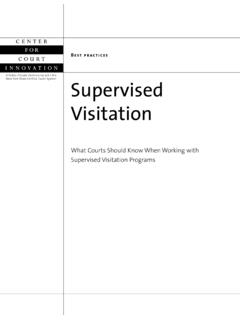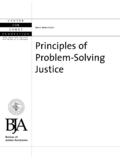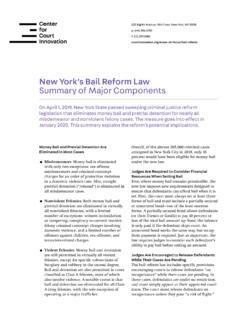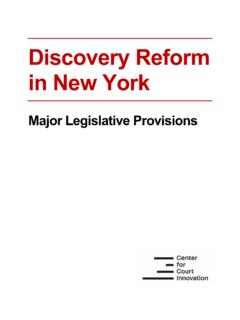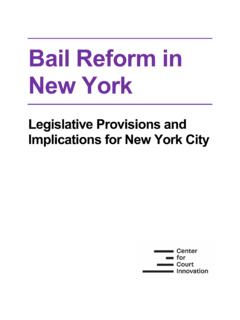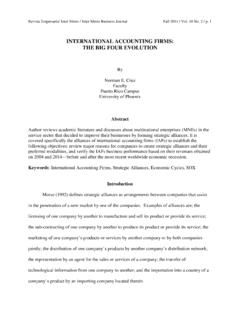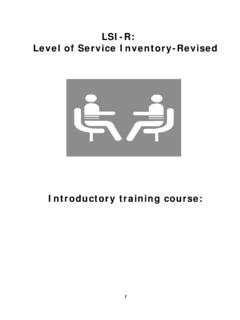Transcription of EVIDENCE-BASED PRACTICES COMMUNITY COURTS …
1 EVIDENCE-BASED PRACTICES , COMMUNITY COURTS , &. MISDEMEANOR OFFENDERS. Challenges & Strategies for Practitioners Julian Adler, Esq., LCSW. Red Hook COMMUNITY Justice Center Center for court Innovation Presentation Overview Provide an overview of the leading framework for EVIDENCE-BASED practice in the criminal justice context;. Discuss how the current framework poses interesting challenges for COMMUNITY court practitioners;. Discuss strategies for conceptualizing and implementing evidence-generating PRACTICES in COMMUNITY COURTS . A Bourgeoning Consensus A recent report from the National Center for State COURTS reflects the increasingly accepted view that a Risk-Need-Responsivity model is the better way to conceptualize interventions aimed at recidivism reduction (National Working Group, 2011).
2 The Risk-Need-Responsivity (RNR) model is perhaps the most influential model for the assessment and treatment of offenders . (Andrews & Bonta, 2007). Risk-Need-Responsivity Model THREE CORE PRINCIPLES. Terminology: A Word of Caution Proponents often use the terms risk and need interchangeably, , defining criminogenic needs as those dynamic risk factors most associated with criminal behavior.. Criminogenic needs are considered dynamic risk factors (NCSC, 2011). Why the Confusion? Familiar Words, Less-Familiar Meanings: Risk = Risk of Reoffending Need = Criminogenic Needs Criminogenic Needs = Factors thought to be most related to re-offending, which by and large conflict with treatment- court logic.
3 More Confusion?! Holy Amalgamation, Batman! Risk/Need Factors! . Remember: Needs = Factors that have been shown (via research) to increase an individual's risk to re-offend. Confusing? Yes! Tautological? No! Risk Principle #1: Risk Principle: Holds that the intensity of intervention should correspond to the offender's level of recidivism risk ( , NOT the severity of the offender's clinical needs): High-Risk = More Intensive Intervention Low-risk = Less Intensive Intervention Risk Principle If one our correctional goals is to reduce offender recidivism then we need to ensure that we have a reliable way of differentiating low risk offenders from higher risk offenders in order to provide the appropriate level of treatment (Andrews &.)
4 Bonta, 2007). What's the Risk of Disregarding the Risk Principle? Best Case Scenario: Depletion of scarce resources. Worst Case Scenario: Increased risk of recidivism for previously low-risk offenders. Need Principle #2: Need Principle: Effective interventions must target particular needs, so-called criminogenic needs, that are directly related to recidivism. The big four . The big four ' are proposed to be the major predictor variables and indeed the major causal variables in the analysis of criminal behavior of individuals (Andrews & Bonta, 2010). Of the four , three are dynamic (changeable via intervention), so we'll focus on those.
5 Criminal History is considered a major risk/need factor; alas, absent a time machine, there is little to be done to address this static risk factor. Dynamic Risk/Need Factors Antisocial Personality Pattern: impulsive, adventurous pleasure-seeking, generalized trouble restlessly aggressive, callous disregard for others.. Antisocial Cognition: attitudes, values, beliefs, rationalizations, and a personal identity that is favorable to crime.. Antisocial Associates: both association with procriminal others and relative isolation from anticriminal others.. The Moderate four . Family/Marital Circumstances School/Work Leisure/Recreation Substance Abuse (Substance abuse?)
6 Did he say, Moderate?! ). What's Missing? Untreated/improperly treated mental illness and trauma/victimization. The minor risk/need factors (and less promising intermediate targets of change) include the following: personal/emotional distress, major mental disorder, physical health issues, fear of official punishment, social class of origin, seriousness of current offense, and other factors unrelated or only mildly related to offending . (Andrews & Bonta, 2010). Responsivity Principle #3: Responsivity Principle: Intervention design should incorporate cognitive behavioral and social learning strategies and be responsive to the specific learning needs of offenders.
7 Eh? Cognitions = Thoughts Proponents of CBT emphasize the relationship between: How we think and how we feel;. How we think and how we act. Ok Eh? Cognitive Social Learning Strategies include: Respectful and collaborative, alliance-oriented approaches;. Teaching various techniques for identifying and managing the relationship between one's thoughts and one's actions, , stop and think;. Modeling appropriate behavior ( , teaching pro- social behavior as an alternative to antisocial behavior);. Positive and negative reinforcement. Risk-Need-Responsivity Model CHALLENGES. A Promising Framework Practitioners and researchers can in fact agree in their identification of a paradigm without agreeing on, or even attempting to produce, a full interpretation or rationalization of it.
8 Lack of a standard interpretation or an agreed reduction to rules will not prevent a paradigm from guiding research.. Thomas Kuhn, The Structure of Scientific Revolutions (1962). That Said . [W]hat EBP proposes requires some counterbalance and caution (Sparrow, 2011). And . You can't shop off the rack! Screening, interventions anyone know a good tailor? The Challenge: Broad Brush The evidence supporting the Risk-Need- Responsivity Model is based on research with felony offenders in correctional settings. When it comes to misdemeanor offenders, there is simply no evidence to suggest this model is effective let alone intelligible.
9 This model raises serious implementation issues for low-leverage cases. The Challenge: Broad Brush AND YET It seems like every RFP demands the use of EVIDENCE-BASED PRACTICES ! Transposing the Risk Principle At the end of the day, risk of re-offending is very much tied to concerns about public safety. In COMMUNITY COURTS , we often see populations that are very high-risk of re- offending BUT at a very low-level, , low- level misdemeanors and violations. Transposing the Risk Principle (Cont.). However, these populations are often very high-need with respect to social services and clinical presentation (but again, low-risk when it comes to committing crimes that seriously threaten public safety).
10 A proponent of the risk principle might suggest less-intensive intervention or no intervention at all even though untreated drug addiction, for example, will almost invariably lead to rearrests for possession. Transposing the Risk Principle (Cont.). Is there even a clear and meaningful way to distinguish high- v. low-risk offenders for the purposes of offering intervention and determining its intensity? Even for low-level and low-risk offenders, a period of inpatient drug treatment is often necessary to kick a 30-year heroin habit Is this too intensive for, say, a charge of criminal trespass or turnstile jumping?
